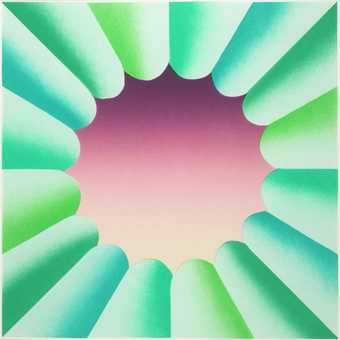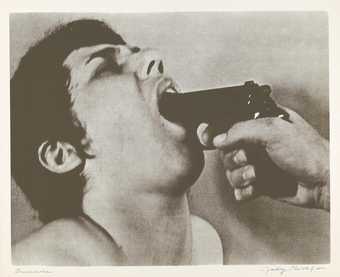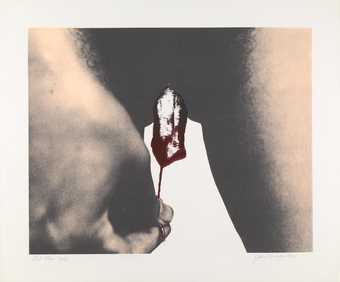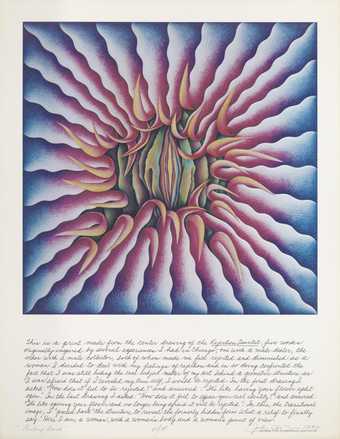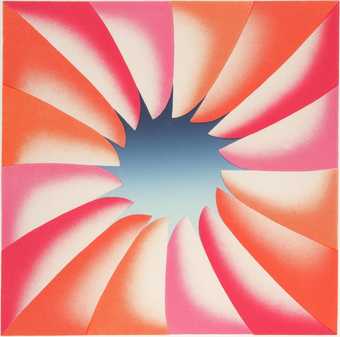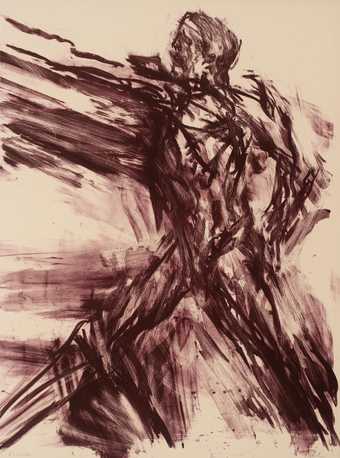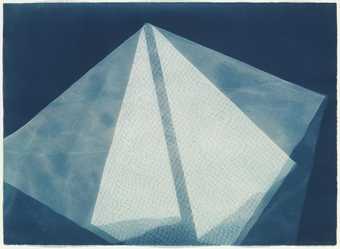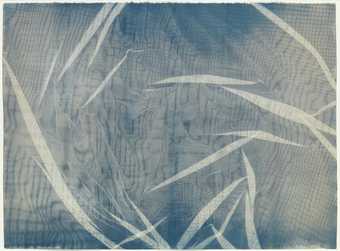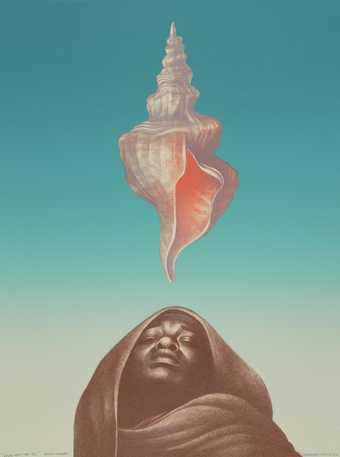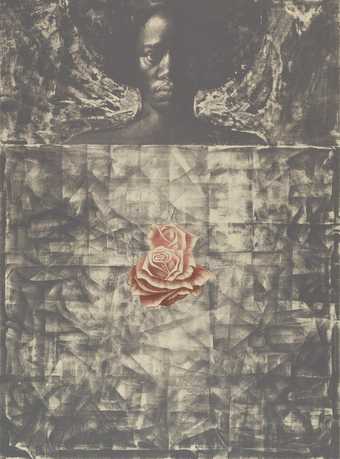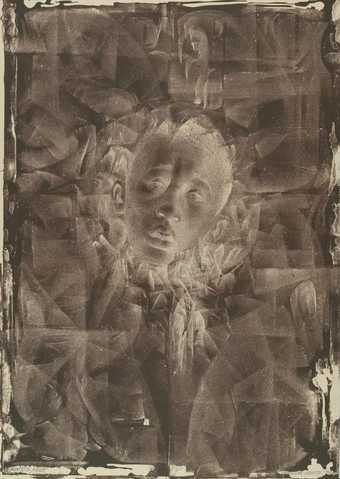
In Tate Liverpool
Ideas Depot
Free- Artist
- Leon Golub 1922–2004
- Medium
- Lithograph on paper
- Dimensions
- Image: 755 × 1050 mm
- Collection
- Tate
- Acquisition
- Purchased 1988
- Reference
- P77250
Catalogue entry
P77250 Wounded Sphinx 1965
Lithograph 755 × 1050 (29 3/4 × 41 1/2) on wove Rives paper, same size; printed by Tamarind Press; publisher not known; edition of 20
Inscribed ‘Golub’ b.r., ‘Wounded Spinx’ b.l. and ‘7/20’ bottom centre
Purchased from Print Works, Chicago (Grant-in-Aid) 1988
‘Wounded Sphinx’, printed in red and blue, depicts a male sphinx with one limb raised and an anguished expression. In conversation at his studio in New York on 2 November 1988, Golub described the sphinx in P77250 as ‘self-wounded’ in one aspect, although he depicted them in related works as wounded by an external being. On an early draft of this entry Golub commented (19 January 1995): ‘Sphinx are agressive. They express also a vulnerability’. P77250 was produced at the Tamarind Lithography Workshop in Los Angeles, where Golub was invited to work for six weeks in the summer of 1965.
The sphinx is an ancient symbol of a division in human consciousness, between the animal and the human, the male and female, reason and instinct. Golub has periodically depicted sphinxes in paintings, drawings and prints since the 1950s. Sphinxes traditionally have human heads and animal bodies, but, on occasion, Golub has depicted ‘Siamese’ sphinxes, with two heads joined at the trunk of the body. Golub made seven paintings and several drawings of this subject between 1954 and 1956, a number of which are reproduced in Donald Kuspit's Leon Golub: Existentialist/Activist Painter (New Brunswick 1985, pp.102–3, 109–112, nos.40–2, 50–4). He made a further group of four sphinx paintings in 1988 (repr. Leon Golub: Paintings 1987–92, exh. cat., Institute of Contemporary Arts, University of Pennsylvania, Philadelphia 1992, pp.11–18 in col.).
In conversation, Golub said that the hybrid nature of the sphinx suggested several conflicts and levels of meaning:
It is a trapped consciouness, because it is a human head inside an animal body. It is in an indeterminate state which has a lot of force, a lot of power, but does not have control over its world on the same terms as we do. For example, the satyr is described as one-third god, one-third human and one-third beast. I have associated that with the tripartite division in Christianity, or the many religions which have heaven, earth and hell. It is like trying to figure out our destinies: who we are, where we come from, where we are going. We are still asking those same questions... The sphinx is one of those kinds of attempts, metaphorically and symbolically, to bridge through imagery social conflict and self-conflict. How much control do we have over ourselves and our environment?
Golub believes that sphinxes are archetypes and present ‘some way of handling the world as a sort of primitivistic cultural construct. They are ritualised and are what we call non-scientific or pre-scientific art, at least by our western notions of science’. In an interview with Kate Horsfield and Lyn Blumenthal given in 1977 Golub said he employed sphinxes to represent human characteristics: ‘The sphinx is a creature who is part human and part animal; therefore, one is indicating characteristics of humans by making sphinxes. There are no such things as sphinxes’ (‘On Art and Artists: Leon Golub’, Profile, vol.2, no.2, March 1982, p.9). He continued:
We live under technologies, automation, and computerized logics which are huge in scope, a mammoth technological society, and at the same time, in a society which is extremely dominating. Now I'm not saying more brutal than other societies but nevertheless very brutal. We operate massive weapons systems and we export these weapons. There was World War II, Korea, Vietnam. How are you going to make contact with these fantastic numbers of slaughters? You can't do it by painting pretty pictures about it. You have to create those kinds of stylized forms... The shock of encountering a brutal, tangible monster [like the sphinx] means that you have to take account of it - you have to figure out why such a thing appears in your world, what it means to exist.
(ibid., p.9)
The sphinxes in Golub's works are all male, with the exception of a female reproduced in a screenprint of 1950 (no repr. known). Donald Kuspit (1985, p.68) suggests that Golub was partly drawn to this subject because of its masculinity:
The fact that Golub's sphinxes are typically male not only shows that he himself identifies with the monster, is victim to a disintegrative feeling of monstrousness, but also, in a patriarchal view which sees the male human as emblematic of the species, asserts the monstrousness of being human in the contemporary, posthumanistic world... Paradoxically, Golub's male sphinxes are not only victims of his world, but symbolize it. In the original story, the sphinx is the predatory, phallic woman seductively consuming her lovers with an incomprehensible riddle which suggests that man himself has no place in the world.
According to Kuspit (ibid., pp.65–8), the sphinx represented a self which has ‘systematized its fragmentation, reconciled its opposites’. Golub's sphinxes do not achieve a new sense of cohesive self or transcend their physical duality. ‘The animal and the human coexist in the self, in a dubious equilibrium in which neither dominates.’ This unreconciled split produced a stalemate and led to the sphinx becoming Golub's ‘most ferocious image’ of what Kuspit described as ‘the dissociation of sensibility, a phenomenon that is seen as modern but that is in fact a split within the archetypal self’.
In conversation with Gerald Marzorati (Gerald Marzorati, A Painter of Darkness: Leon Golub and our Times, New York 1990, p.203), Golub described cyborgs, a fictional invention of the scientific age, as a contemporary equivalent of sphinxes:
A cyborg is a creature. Part human, part machine, part computer intelligence. Beyond human, in a sense. Real, but simulated. Powerful - more powerful than you or me. Yet vulnerable, too, but not exactly in the way we are vulnerable. The sphinxes were the cyborgs of their age. I mean, what I'm saying - what interests me - is that throughout Western civilization, there has always been this notion of crossings of this kind, extraordinary mixes of man and animal.
In conversation, Golub said that he tried to inject his sphinxes with ‘a sense of tension and malaise, because they cross borders and can be a symbol of stress and tension’.
The artist has approved this entry.
Published in:
Tate Gallery: Illustrated Catalogue of Acquisitions 1986-88, London 1996
Explore
- abstraction(8,615)
-
- from recognisable sources(3,634)
-
- figure(2,270)
- emotions and human qualities(5,345)
-
- aggression(100)
- psyche(19)
- gestural(763)
- destruction(383)
- menace(209)
- wounded(135)
- classical myths: creatures(143)
-
- Sphinx(10)
You might like
-
Barbara Kasten Untitled 13
1979 -
Judy Chicago Through the Flower #2
1972 -
Judy Chicago Gunsmoke
1971 -
Judy Chicago Red Flag, Artist Proof 4
1971 -
Judy Chicago Peeling Back
1974 -
Judy Chicago Through the Flower #3
1972 -
Judy Chicago Through the Flower #4
1972 -
Leon Golub Fighter
1965 -
Leon Golub White Squad
1987 -
Leon Golub Vietnam II
1973 -
Barbara Kasten Photogenic Painting, Untitled 74/13
1974 -
Barbara Kasten Photogenic Painting, Untitled 74/3
1974 -
Charles White Wanted Poster Series #14a
1970 -
Charles White Love Letter
1971 -
Charles White Love Letter II
1977


